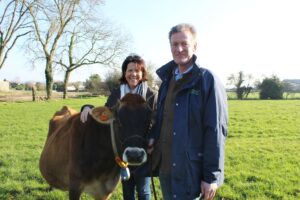
We continue our series of article in Jèrriais – Jersey’s own traditional native language. The ‘frouque’ in question is a digging fork, rather than a table fork. An English translation follows. This contribution comes from Rod McLoughlin
Bouônjour bouannes gens,
I’ y’a deux’-trais s’maines, j’fis eune pronm’nade à Sandybrook au c’mîn d’pèrquage tchi mène jusqu’à la grève dé St Aubîn près dé Gunsite Café. La pronm’nade m’a fait penser à un sujet qu’les lecteurs pus vièrs peuvent bein comprendre. Lé fait tchuthieux qué l’temps sembl’ye pâsser pus vite quand nou d’veint pus vyi. Quand nou-s-est janne nou n’peut pon s’înmaginner eune période dé 25 années mais, aniet, les choses tchi s’pâssitent i’ y’ a plusieurs années sembl’yent assez récentes.
J’sis à penser à chennechîn pa’ce qué, quand j’tais mousse, jé d’meuthais à Beaumont don ma pronm’nade mé fit r’tracer les pas qué j’prannais souvent à la fîn d’s années 60. Dans chu temps-là, mes pathents avaient arrivé en Jèrri pouor dirigi eune hôtel – ou un ‘guest house’ – auve siêx p’tites chambres et raiqu’eune salle dé bain, chârée entre tous les clients. Aniet i’ y’ a peu d’hôtels comme chenna mais, dans chu temps-là, quand Jèrri avait 25,000 lyits pouor les visiteurs, ch‘ ‘tait normal. Châque année, entre Avri et Octobre lé ‘guest house’ ‘tait tout pliein d’visiteurs Angliais tchi souvent faîsaient lus rêsèrvâtions pouor l’année tchi v’nait d’vant d’èrtouônner siez ieux. Ch’tait populaithe viyant qu’la grève ‘tait d’l’aut’ côté d’la rue.
En driéthe dé l’hôtel, à côté du c’mîn d’pèrquage, i’ y’ a un clios où’est qu’dans chu temps-là l’s êtchipes jouaient l’rugby. À l’âge dé 8 ans eune chose mé semblyit assez êtrange. Entre lé bord du tèrrain et lé c’mîn d’pèrquage, i’ y’ avait eune camboûse en chînment pouor eune seule pèrsonne. Ch’ ’tait tchuthieux dé trouver eune telle chose là et j’n’avais aucheune idée dé sa sîngnificâtion. Et pis, j’m’apèrchus dé tchiquechose d’autre. Au bord du c’mîn, i’ y’ avait des pilièrs tenvres en chînment dé trais mètres dé haut. Jé m’ramémouaithis qu’j’avais veu les mêmes pilièrs dans les portraits des prisons duthant la deuxième dgèrre mondiale.
Quand j’fus pus âgé, j’ réalisis qu’i’ ‘taient l’s ênas d’ l’Otchupâtion et qué l’trantchil’ye clios d’rugby ‘tait, duthant la dgèrre, un site (ou « un empliaichement ») pouor les cheins tchi travaillaient comme escliaves pouor l’s Allemands, en bâtissant les fortificâtions à l’entou d’l’île. I’ bâtissaient les tonnelles souôtèrraines ou l’Hôpita souôtèrrain, et l’drannet d’tonnelles dans la Vallée d’St Pièrre.
Les visiteurs dé l’Angliétèrre pouvaient pâsser deux s’maines heûtheuses en Jèrri sans penser à la souffréthie d’s escliaves tchi fûtent là, à chent mètres dé lus hôtel, 25 années d’vant, duthant l’Otchupâtion.
Pus dé 5000 escliaves travaillaient à bâti les fortificâtions à mains d’deux kilomètres dé Goose Green Marsh. Au c’menchement d’l’Otchupâtion les travailleurs d’vaient marchi dé St Hélyi jusqu’à Beaumont mais pus tard, quand l’învâsion d’ l’Ûrope s’approchit, lé site à Goose Green March s’ouvrit pa’ce qué l’s Allemands avaient bésoin dé pus d’main-d’oeuvre. II’ avaient décidé d’transformer les tonnelles en hôpita pouor les bliessés auprès l’învâsion.
Mais ouaithe qué l’învâsion d’l’Ûrope s’pâssit en Juîn 1944 sus les grèves d’ la Nouormandie (ou « la Grand’Tèrre), Jèrri restit trantchil’ye. Lé preunmié minnistre Winston Churchill pensait qu’nou pouôrrait laîssi les soudards Allemands ichîn sans nouôrrituthe.
Quand j‘tais mousse, jé n’savais rein entouor tout ch’nna et jé n’fis autcheune connexion entre l’Hôpita souotèrrain et l’clios près d’ siez mé. Si j’y avais pensé, j’l’éthais considéthé comme tchiquechose si êlouongni d’ma vie qu’i’ pouôrrait êt’ dans un monde compliètement difféthent. J’avais 11 ans quand jé tchittînmes l’hôtel à Beaumont et la Libéthâtion s’était pâssée 25 années d’vant.
Aniet lé tèrrain d’rugby n’existe pus et en dgise dé ch’na, i’ y’ a des vaques dans l’ clios. Nou n’peut d’aut vaie la p’tite camboûse. J’crai qu’oulle est couvèrte par des ronches et des feûgiéthes mais nou peut acouo vaie les vièrs pilièrs en chînment tchi supportent lé fi barbé.
Tchiquefais j’m’arrête pouor contempler la veue des clios tchi m’restent acouo fanmilièrs et j’pense comme ch’est êtrange qué des choses si êffritantes ont pu s’pâsser si proche dé man siez mé. Mais j’sis frappé par tchiquechose d’autre : lé mysthéthe d’la pâss’sie du temps. Aniet 25 années m’sembl’yent eune période du temps assez courte, don j’sis chotchi d’penser qu’ches escliaves pâssitent avau l’même c’mîn – comme nou vaie dans l’ dessîn célèbre dé l’artiste Edmund Blampied au mûsée – en 1945. Ch’na fut la même période dé 25 années.
English translation:
Hello everyone,
Two or three weeks ago I went for a walk at Sandybrook along the perquage path which leads to St Aubin’s beach near the Gunsite café. The walk made me think of a subject that older readers will well understand. The strange fact that time seems to pass more quickly when we get older. When one is young, one cannot imagine a period of 25 years but today things which took place many years ago seem quite recent.
I started to think about that because, when I was young, I used to live at Beaumont, so my walk made me retrace steps which I often used to take at the end of the 1960s. At that time, my parents had come to Jersey to run a hotel – or a guest house – with six small rooms and a single bathroom shared by all the clients. Today there are few hotels like that but at that time, when Jersey had 25,000 beds for visitors, it was normal. Every year from April to October the guest house was full of English visitors who would often make their reservations for the following year before they went home. It was popular because the beach is on the other side of the road.
Behind the hotel, next to the perquage path, there is a field where at that time teams would play rugby. At the age of 8 one thing seemed strange to me. Between the edge of the field and the perquage path, there was a cement hut for one person. It was odd to find something like that there and I had no idea of its significance. But later I noticed something else. Along the edge of the path there were thin cement pillars three metres high. I remembered that I had seen the same pillars in photos of prisons during the second world war.
When I was a bit older, I realised that they were the remains of the Occupation and that the quiet rugby pitch was, during the war, a site for those who worked as slaves for the Germans, making the fortifications around the Island. They built the underground tunnels, or Underground Hospital, and the network of tunnels in St Peter’s Valley.
The English visitors could spend two happy weeks in Jersey without thinking of the suffering of the slaves who were there, 100 metres from their hotel 25 years before during the Occupation.
More than 5000 slaves worked to build the fortifications less than 2 kilometres from Goose Green Marsh. At the start of the Occupation, the workers had to walk from St Helier to Beaumont but later, when the invasion of Europe was approaching, the site at Goose Green Marsh opened because the Germans needed more labour. They had decided to transform the tunnels into a hospital for casualties after the invasion.
But although the invasion happened in June 1944 on the beaches of Normandy, Jersey remained quiet. The Prime Minister Winston Churchill thought one could leave the German soldiers here without food.
When I was young, I knew nothing about all this, and I made no connection between the Underground Hospital and the field near my home. If I had thought about it, I would have considered it something so far from my life that it could have belonged to a completely different world. I was 11 when we left the hotel at Beaumont and the Liberation had taken place 25 years before.
Today the rugby pitch no longer exists and instead there are cows in the field. One cannot see the hut. I think that it is covered by bracken and brambles, but one can see the cement pillars which supported the barbed wire.
Sometimes I stop to look at the view of the field which still seems familiar, and I think how strange it is that such terrifying things could have happened so close to my home. But I am struck by something else – the mystery of the passing of time. Today 25 years seems to me quite a short period of time, so I’m shocked to think of the slaves passing along the same path – like one can see in the famous drawing in the museum by the artist Edmund Blampied – in 1945. That was the same period of 25 years.





One Response
Your article prompted me to remember an overnight stay I had in hospital some years ago. Two old chaps occupying beds next to each other were talking in Jersey French. They had not met since they were at Elementary School together. One of them said that he still had nightmares as a result of an encounter he had had as a youngster at Les Landes. He had witnessed a Todt guard striking a young slave worker, possibly no more than 16 years old, with a pickaxe handle. He had felt too intimidated to intervene. He had never been able to forget the boy’s screams which came back to haunt him particularly at night. Time past can still very much be present with us today.